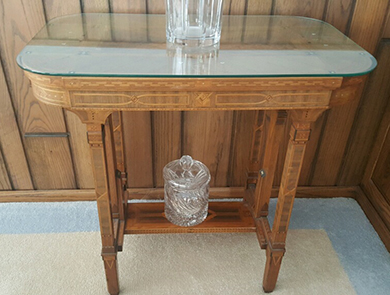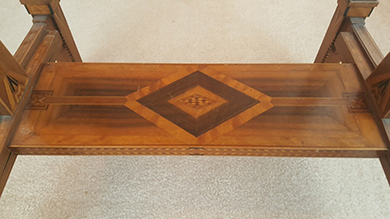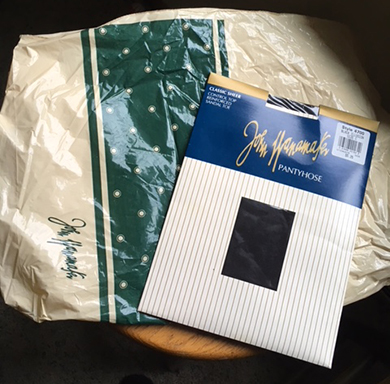 |
|
|||
 |
 |
|||
RINKER ON COLLECTIBLES — Column #1629 Copyright © Harry Rinker, LLC 2018 Questions
and Answers
QUESTION: I own a table that was built in 1928 by Herman Jaeger, a one-eyed cabinetmaker who live in Milwaukee, Wisconsin. The table marquetry utilized over 21,355 pieces of inlaid wood. The table was exhibited at the 1933-1934 Chicago World’s Fair where Jaeger supposedly was offered $5,000.00 for it. The “Milwaukee Journal” published an article about the table. What is the value of the table in today’s marketplace? If I wished to sell it, what advice do you have? – TB, Okauchee, WI, Email Question 
ANSWER: The pictures that accompanied your email illustrate the detailed inlay work. The next step is to authenticate the backstory. Since you did not include a copy of the “Milwaukee Journal” article, I assume you do not have it, only knowledge it once existed. You need to locate the article. Hopefully, the article was written during the 1933-1934 Chicago World’s Fair or immediately thereafter. Even if the article mentions the Fair, you need to determine the building and exhibit in which it appeared. Detailed records were kept of pieces exhibited at World’s Fairs, especially those occurring between 1876 and the mid-20th century. Begin your research at the Chicago Historical Society. You must establish the ownership provenance from the time Jaeger made the table to the time you acquired it. If the table descended other than through the family, this may be difficult. Finally, you need to assemble a biography of Herman Jaeger. I did a quick “Find a Grave” search and came up with a Herman Jaeger (1869-1951) who is buried in the Glen Oaks Cemetery in Milwaukee, Wisconsin. Given the popularity of the Jaeger name in the region, this is a“shot in the dark.” There is no guarantee your Herman Jaeger is buried in Wisconsin, let alone Milwaukee. When I expanded the search to “Wisconsin,” “Find a Grave” produced eight results, a smaller number than I would have guessed. 
The above information is critical because the value of this table is in its story and not in the table itself. The table is a curiosity made during a time when curiosities were prevalent. Tramp Art is one example. I lost count of the number of elaborate architectural and other objects I have seen made out of matchsticks, popsicle sticks, porcupine needles, toothpicks, and other material during my career, not the least of which was a picture of a three-dimensional model of San Francisco made using over 100,000 toothpicks. The golden age (the first half of the 19th century) of these curiosities has long passed. The main buyer for them today is Ripley’s Believe It or Not. To some extent, the same was true in 1933. Robert Ripley’s first public display of his collection was at the 1933-1934 Chicago World’s Fair. His Ripley’s Odditorium attracted more than two million visitors. Is it too much of a stretch of the imagination to believe the individual who offered Jaeger $5,000 for the table was Robert Ripley? Jaeger should have accepted the $5,000.00 and invested it. Based solely on inflation, the value in March 2018 is $94,093.13. In today’s secondary marketplace, the table’s value is around $1,500.00. Given its provenance, the table’s maximum value is in Chicago or Milwaukee. Chicago’s Ripley’s Believe It or Not is gone. There is one in the Wisconsin Dells. The best sale approach is auction. Contact Leslie Hindman. It most likely will not meet her minimum, but she may accept it because it fits the Monty Python philosophy “and now for something completely different.” . 
QUESTION: I have two boxed board games. The first is “Captain and the Kids” made by Milton Bradley in 1947. All the pieces are present. The box has minor corner damage which was taped over years ago. The second is called “Bop the Beetle” made by Ideal in 1962. The box is in good shape. The frog/beetle shows no wear. It also is complete. What are my games worth? – RJ, Lowell, MA, Email Question ANSWER: Boardgamegeek.com is my primary source for information about board games. Like many licensed board games, the box graphic and game board are the two main value factors. In the case of Captain and the Kid, value rests heavily on the cover art. The cover shows Mama holding a rolling pin chasing The Captain with several other characters from the comic strip located near him. Dirks’ “The Katzenjammer Kids” comic strip began in 1897 and was syndicated by Hearst. In 1912-1914, Dirks became involved in a legal battle with Hearst. He left and started the comic strips “Hans and Fritz” and “The Captain and the Kids” using the same characters as in “The Katzenjammer Kids.” The dueling cartoon strips continued until 1979 when “The Captain and the Kids” ceased publication. A check of recent sales on WorthPoint.com indicates a secondary market value of between $50.00 and $60.00, down from a high of over $100.00 five years ago. Unlike “Captain and the Kids,” which is a licensed comic board game, “Bop the Beetle” is a generic game. Normally, generic games have little collector value. “Bop the Beetle” has more collector interest than I thought. WorthPoint.com lists several examples that were complete and in the period box that sold between $25.00 to just over $50.00 in 2017. These sale results reflect a generation “buy back my favorite childhood toy” price. This is a peak secondary market price. Prices will begin to decline in five to 10 years. QUESTION: I have a period package of John Wanamaker Pantyhose. It is accompanied by a plastic John Wannamaker’s bag with a holiday scene. Do these items have value? – CB, Reading, PA, Email Question 
ANSWER: Philadelphia was the flagship location of the John Wanamaker Department Store established in 1861 The store was a Philadelphia institution. Wanamaker survived until 1994, when Woodward & Lothrop, who owned it at the time, filed for bankruptcy. Today, the store is home to Macy’s. I have a small collection of nylons in their period packaging from the 1950s through the 1970s and girdle boxes. Before readers get the wrong idea, it is the period packaging that attracts me and not the contents. I never added pantyhose to the collection because of its bland packaging. Obsolete department store memorabilia has value only in the area where the store or its branches were located. Reading is close enough to Philadelphia to fall within this guideline. However, the value is minimal. If someone offers you between $3.00 and $5.00 for the two pieces, kiss the hand and take the money. QUESTION: I have two candy dishes. Each consists of two attached dishes with a handle in the center. The dish with a blue ground and floral motif is marked “Made in Italy” and measures 8-inches wide. The other dish has a branch and leaf motif on a mottled ground and is 10-inches in length. This belonged to my grandmother. It is marked, but I cannot make it out. I think they date from the 1940s or 1950s. Do these dishes have any value? – CR, Pottsville, PA, Email Question 
ANSWER: The answer is no and yes. The no relates to financial value. Although you are correct in dating them to the late 1940s or early 1950s, they are fifty cents to two-dollar garage sale fodder. Collector interest, except from “tacky” collectors, is minimal. Family value is the key to your grandmother’s dish. Put candy in it. Each time you take a piece, smile and remember your grandmother Harry L. Rinker welcomes questions from readers about
collectibles, those mass-produced items from the twentieth and twenty-first centuries.
Selected letters will be answered in this column.
Harry cannot provide personal answers.
Photos and other material submitted cannot be
returned.
Send your questions to: Rinker on Collectibles, 5955 Mill
Point Court SE, Kentwood, MI 49512.
You also can e-mail your questions to
harrylrinker@aol.com.
Only e-mails containing a full name and mailing address
will be considered.
You can listen
and participate in
WHATCHA GOT?, Harry’s
antiques and collectibles radio call-in show, on Sunday mornings between 8:00 AM
and 10:00 AM Eastern Time.
If you
cannot find it on a station in your area,
WHATCHA GOT?
streams live on the Internet at www.gcnlive.com.
|
||||